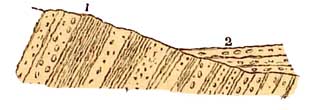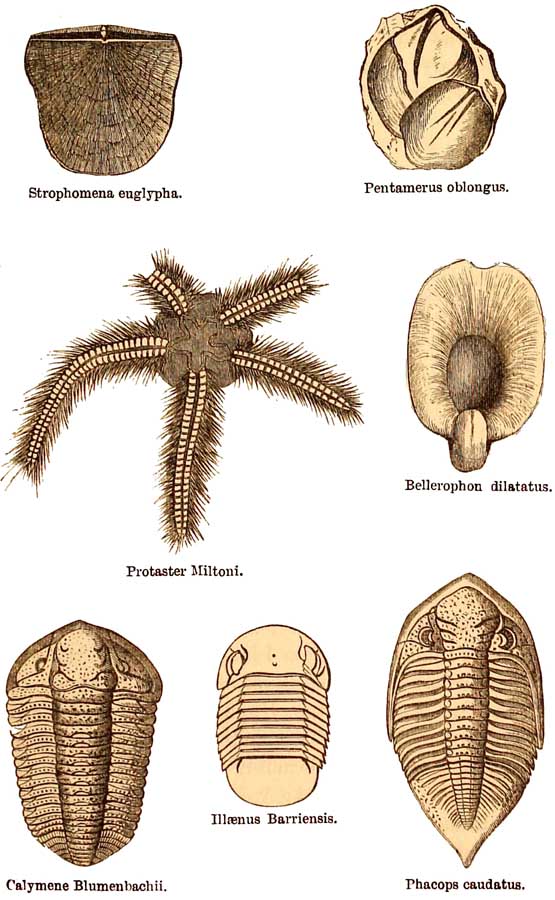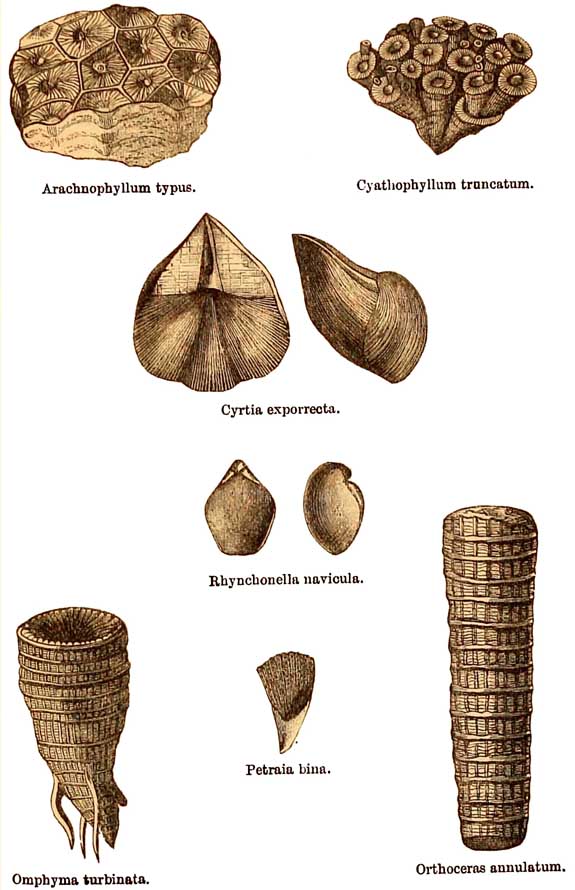CHAPTER VII.
UPPER SILURIAN SERIES.
THE stratigraphical order of the UPPER SILURIAN SERIES is shown in the table p. 30. They
were deposited under the following circumstances :—The Lower Silurian rocks in large areas in
the British Islands and in some other areas, were upheaved, more or less contorted, and in many
places suffered a great amount of denudation before the deposition of the Upper Silurian strata
began, which, therefore, in various districts lie quite unconformably upon them. In the
FIG. 19.

1. Caradoc sandstone (Lower Silurian)
2. Upper Llandovery beds.
3. Wenlock shale.
4. Wenlock limestone.
5. Upper Ludlow.
6. Aymestry limestone.
7. Upper Ludlow.
8. Old Red Sandstone.
typical district of Wenlock and Ludlow the arrangement of the various subdivisions of these
Upper Silurian strata is as shown in figs. 19 and 22, the bands of limestone generally forming
bold terraces, that look
[Upper Silurian Rocks. 89]
north-westward to the mountains of the Longmynd beyond Le Botwood and the beautiful valley of
Church Stretton.
Notwithstanding the unconformity mentioned above, there are in Wales, and partly in
Shropshire, rocks containing suites of fossils, many of them peculiar to the horizon in which
they occur, and a few common to Upper and Lower Silurian. Part of these strata, such as the
Lower Llandovery beds, have been formed during minor oscillatory movements of sea and land.
In South Wales, Stricklandinia (Pentamerus) lens occurs plentifully in these Lower
Llandovery rocks, and sparingly in the Upper Llandovery rocks; while P. oblongus occurs
sparingly in the Lower Llandovery rocks, and in great numbers in the Upper Llandovery beds,
on which rests the Tarannon shale. By far the larger part of the fossils of the Lower Llandovery
rocks are, however, essentially of Lower Silurian type, and, besides, they are quite
conformable with, and pass by easy lithological gradation into the underlying strata.
With the Upper Llandovery or Pentamerus beds,1 as they were formerly called, the case is very
different, for in Shropshire they rest urtconformably on the Cambrian and Lower Silurian
rocks indiscriminately, and possess a beach-like character, being in places formed of pebbles
derived from the rocks on which they rest, as in fig. 20, and in Radnorshire near Builth, the
Upper Silurian rocks including these Pentamerus-bearing strata, lie with extreme
unconformity, alike on the lowest and the highest Llandeilo and Caradoc beds of that old volcanic
area, as shown in figs. 20, 21, 22.
My belief, therefore, is that these Upper Llandovery beds, which form the true base of our
Upper Silurian
1 See fig. 23, p. 94, Pentameris oblongus is so common in these
strata that they were originally called Pentamerus beds.
[90 Llandovery Beds.]
strata wherever they occur, were often beaches of the period; and this is further proved by the
fact that they are often conglomeratic, containing rounded pebbles derived from the rocks on
which they rest, while, as at May Hill and Woolhope, they are coarsely sandy.
From these facts we arrive at the conclusion that during the beginning of Uppper Silurian times,
part of
FIG. 20.

1. Cambrian rocks.
2. Pentamerus limestone and conglomerate.
the area now called Wales consisted of islands formed of Lower Silurian strata and volcanic
rocks, round which the occasional consolidated beaches are still visible.
Going further into the physical geology of this epoch, we find that in South
Wales the Upper Llandovery beds lie imconformably on a large scale on the
Llandeilo and Caradoc series, a fact proved by the conflicting dips and strikes
of the two sets of strata; while in North Wales, similar conflicting strikes,
and the steady overlapping of the Upper on the Lower Silurian beds, proves
the same fact, for east of Bala the base of the Upper Silurian beds lies
about 2,000 feet above the Bala Limestone, while in the neighbourhood of
Conway they almost touch that horizon.
Another important point connected with the physical geography of the period is that, after a
time, the Lower Silurian islands and other areas began to undergo a process of slow depression
beneath the sea. If we
[Physical Geografthy. 91]
turn to the Shropshire area
between Church Stretton and Chirbury, including the Cambrian rocks of the
Longmynd, this is what we find. On the vertical and highly inclined strata
of the Cambrian and Lower Silurian rocks, the conglomerates and limestones
of the Upper Llandovery beds form in the lower country a kind of narrow fringe,
surrounding great part of the area, and lying from 500 to 900 feet lower
than the broad, flat-topped, and gently undulating hills of the Longmynd
and Shelve. Almost on the highest level of one of these fiats, at the well
known Bog-mine, there is a small outlying patch of Upper Llandovery beds,
formed of hard quartzose sandstone, at a height of 1,150 feet above the sea,
as roughly indicated in the following diagram.
FIG. 21.

1. Cambrian grits, &c.
2. Lingula flags.
3. Tremadoc and Llandeilo beds.
4. Pentamerus beds.
5. Wenlock shale.
The inference is obvious, that these Pentamerus-bearing strata began to be deposited at the bases
of the hills, and that by degrees, during a process of slow submersion, the sea crept on and on
inland, accompanied by the deposition of marginal Upper Llandovery beds, till at length, like an
island in the coral seas of the Pacific (but without the corals), this old Silurian Isle was
entirely swallowed up and buried, deep beneath the succeeding great accumulations of Upper
Silurian strata, which in. the adjoining area of Wenlock and
[92 Physical Geography.]
Ludlow are more than 3,000 feet in thickness. The original extent of this long-buried island,
may have been about 24 miles in length by 14 in breadth, about the size of the Isle of Man.
The same fate was undergone by the Llandeilo and Caradoc rocks, that with lavas, ashes, and
intrusive greenstones, now lie between Builth and Llandegley in Radnorshire. This island was,
however, lower and
smaller, its length having been about 20 miles, by 10 at its greatest breadth.
That these two tracts of land stood as islands in an early Tipper Silurian sea, I have no doubt;
and on grounds less definite, I am of opinion, that at the very beginning of the Upper Silurian
epoch, the greater part of Wales, both south and north, formed land, some of it higher than now,
for since that time the Lower Silurian rocks of that region have undergone great and repeated
denudations. As, however, the deposition of the Upper Silurian formations progressed, a steady
submersion took place of the neighbouring land, from the waste of which, sediments were
derived; but whether or not its highest mountains were swallowed up and buried before the
close of the Upper Silurian epoch I am quite unable to say. That this entire burying of the Lower
Silurian rocks of Cumberland took place, seems most probable; and while the Lower Silurian
rocks of the Highlands of Scotland, and the West of Ireland, certainly formed high land during
the beginfling of Upper Silurian times, I have no precise data by which to determine what was
their subsequent fate.
A section of the Silurian strata, as seen near Caer Caradoc and Wenlock, is shown in fig. 22.
The same kind of development passes southward beyond Ludlow, forming beautiful scarped
woody
[Upper Silurian Rocks. 93]
terraces, but beyond that into South Wales the limestones disappear, or are occasionally only very
feebly represented, and the whole consists chiefly of shales, sometimes sandy, in which no
definite lines of subdivision for the subformations can be drawn.
FIG. 22.

1. Caradoc sandstone. (Lower Silurian).
Upper Silurian:
2. Upper Llandovery limestone and sandstone
lying unconformably on No. 1.
3. Wenlock shale.
4. Wenlock limestone.
5. Lower Ludlow shales, concretionary.
6. Aymestry limestone.
7. Upper Ludlow sandy flags and shales.
8. Passage beds, and
9. Old Red Sandstone.
Far east of this, at Usk, Woolhope, May Hill, the Malvern and Abberley Hills, and at Dudley and
Walsall, the limestone formations (so-called) are well developed, while in North Wales the
Upper Silurian rocks chiefly consist of shales and interstratified grits without any bands of
limestone. Near Llangollen, where the shaly strata are much affected by cleavage, they become
true slate. In Scotland, the Upper Silurian rocks occur between the Solway Firth and the Cheviot
Hills, and are said to lie unconformably on the Lower Silurian strata. Further north they only
occupy small areas near Lesmahago, and at the north-west base of the Pentland Hills.
All of these formations are in general terms fossiliferous. The Wenlock limestone is in great
part
[94 Upper Silurian Fossils.]
FIG. 23.

Group of Upper Silurian Fossils.
[Upper Silurian Rocks. 95]
formed of Corals, Encrinites, Mollusca, and Trilobites, Corals often predominating. The most
characteristic shell of the Aymestry limestone is Pentamerus Knightii.
The grouping of fossils in the Upper Silurian rocks is in general terms much
the same as in the Lower series, although new genera appear, but a very large
proportion of more than 700 Llandeilo and Caradoc species were extinct in
our area, only about 16 1/2 per cent. being common to the Lower and Upper
series. The Corals, which are in general not very numerous in British Lower
Silurian rocks, have increased to 82 species of 27 genera, of which 15 genera
and about 65 species are new. The Echinodermata (stone lilies) increase to
55 species, only 1 specie of which, an Actinocrinus, is common to Lower and Upper Silurian rocks. Several new starfish
appear, especially in the Upper Ludlow rocks. There is one true Echinus (sea-urchin),
Palœchinus. In Britain the Trilobites decrease to 30 genera and about 130 species. Among the
Hydrozoa the Graptolites decrease to 3 species in Britain; and there are about 20 known species
of Polyzoa. There are 21 genera and 126 species of Brachiopoda. Among these, of the genus
Atrypa there are 8 species. Athyris and Obolus appear for the first time in lists of fossils.
Leptœna from 10, decreases to 6 species; Orthis from 58 to 21; while Rhynchonella increases
from 12 to 16, and Strophomena decreases from 27 to 15. Of the genus Spirifera there are 3
species in the Lower Silurian rocks, and 8 in the Upper. In all, 21 genera and about 126
species of Brachiopoda are known in the British Upper Silurian strata, and 22 genera and 171
species in the Lower. The Lamellibranchiate mollusca increase from 17 to 18 genera, and from
71 to 87 species,
[96 Bone Beds.]
most of the latter being new. There are 7 species of Pteropoda of 3 genera. It is remarkable that
the described Gasteropoda only amount to 15 genera and 52 species, while in Bohemia, in
equivalent rocks, 200 species, some years since, are mentioned by Barrande, and as many of
the Brachiopoda and Lamellibranchiate molluscs. Of the Nucleobranchiata 10 Bellerophons are
known, and 7 genera and 53 species of Cephalopoda, among which the genus Orthoceras
decreases from 42 to 35 species.
Near the top of the Upper Ludlow strata there are several thin bone beds, containing teeth and
scales of small Placoid fish of the genera Onchus (?) Sphagodus, and Thelodus. At present these
are the oldest known fishes. They are found in strata which contain several species of the
remarkable crustaceans Pterygotus and Eurypterus, some of which are small in size, while the
largest Pterygotus, discovered by Dr. Slimmon near Lesmahagow, in the uppermost Silurian
rocks, attained about 9 feet in length. The very uppermost Silurian beds in England sometimes,
as, for example, near May Hill, contain the remains of landplants, consisting of small pieces of
undetermined twigs, and the sporecases of one of the Lycopodiaceæ Pachytheca spherica.
In these last-named facts there is much significance, bearing on the physical geography of the
next so-called geological epoch, which will be explained in the subsequent chapter. In the
meanwhile I may remark, that I use the words so-called geological epoch, in the same sense that
the words epoch or period are employed in dealing with civil or political events. Taking the
geological world, and the civil world, which deals with the history of man as parallel, there is
no break in time
[Upper Silurian Fossils. 97]
FIG. 24.

Group of Upper Silurian fossils.
[98 Geological Epochs.]
in either case. In the latter, certain remarkable events induce us to break it into periods,
characterised by special events, which were always led up to gradually by broad changes of
power or of opinion. In the former, there are often great breaks in the chain of geological
history, which, locally, are not filled up by stratigraphical deposits, and which under these
circumstances form definite geological epochs, while in other cases (as in Civil history), the
change of conditions was so great in, given areas, that the new series of events may be locally,
classed as constituting new geological epochs. This is eminently the case when we attempt to
realise the history of the Old Red Sandstone, as locally and physically distinct from that of the
Contemporaneous Devonian, strata.






